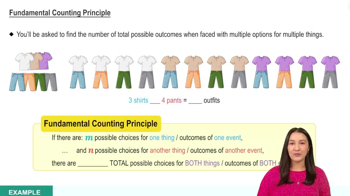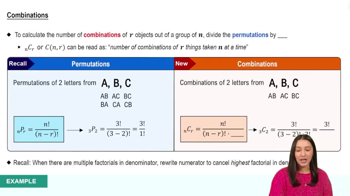Notation What does the symbol ! represent? The five starting players of an NBA basketball team can stand in a line 5! different ways, so what is the actual number of ways that the five players can stand in a line?
Table of contents
- 1. Intro to Stats and Collecting Data1h 14m
- 2. Describing Data with Tables and Graphs1h 55m
- 3. Describing Data Numerically2h 5m
- 4. Probability2h 16m
- 5. Binomial Distribution & Discrete Random Variables3h 6m
- 6. Normal Distribution and Continuous Random Variables2h 11m
- 7. Sampling Distributions & Confidence Intervals: Mean3h 23m
- Sampling Distribution of the Sample Mean and Central Limit Theorem19m
- Distribution of Sample Mean - Excel23m
- Introduction to Confidence Intervals15m
- Confidence Intervals for Population Mean1h 18m
- Determining the Minimum Sample Size Required12m
- Finding Probabilities and T Critical Values - Excel28m
- Confidence Intervals for Population Means - Excel25m
- 8. Sampling Distributions & Confidence Intervals: Proportion1h 12m
- 9. Hypothesis Testing for One Sample3h 29m
- 10. Hypothesis Testing for Two Samples4h 50m
- Two Proportions1h 13m
- Two Proportions Hypothesis Test - Excel28m
- Two Means - Unknown, Unequal Variance1h 3m
- Two Means - Unknown Variances Hypothesis Test - Excel12m
- Two Means - Unknown, Equal Variance15m
- Two Means - Unknown, Equal Variances Hypothesis Test - Excel9m
- Two Means - Known Variance12m
- Two Means - Sigma Known Hypothesis Test - Excel21m
- Two Means - Matched Pairs (Dependent Samples)42m
- Matched Pairs Hypothesis Test - Excel12m
- 11. Correlation1h 6m
- 12. Regression1h 50m
- 13. Chi-Square Tests & Goodness of Fit1h 57m
- 14. ANOVA1h 57m
4. Probability
Fundamental Counting Principle
Problem 3.1.37
Textbook Question
Using the Fundamental Counting Principle In Exercises 37-40, use the Fundamental Counting Principle.
37. Menu A restaurant offers a $15 dinner special that lets you choose from 6 appetizers, 12 entrées, and 8 desserts. How many different meals are available when you select an appetizer, an entrée, and a dessert?
 Verified step by step guidance
Verified step by step guidance1
Step 1: Understand the Fundamental Counting Principle, which states that if there are multiple choices for different stages of a process, the total number of outcomes is the product of the number of choices at each stage.
Step 2: Identify the choices available for each stage in the problem. Here, the restaurant offers 6 appetizers, 12 entrées, and 8 desserts.
Step 3: Multiply the number of choices for appetizers, entrées, and desserts to find the total number of possible meal combinations. Use the formula:
Step 4: Substitute the values into the formula:
Step 5: The result of the multiplication will give the total number of different meals available. Perform the calculation to find the final answer.
 Verified video answer for a similar problem:
Verified video answer for a similar problem:This video solution was recommended by our tutors as helpful for the problem above
Video duration:
1mPlay a video:
Was this helpful?
Key Concepts
Here are the essential concepts you must grasp in order to answer the question correctly.
Fundamental Counting Principle
The Fundamental Counting Principle states that if there are 'n' ways to do one thing and 'm' ways to do another, then there are n × m ways to perform both actions. This principle is essential for calculating the total number of combinations in scenarios where multiple choices are involved, such as selecting items from a menu.
Recommended video:

Fundamental Counting Principle
Combinations
Combinations refer to the selection of items from a larger set where the order does not matter. In the context of the restaurant menu, each choice of appetizer, entrée, and dessert represents a combination of items that can be selected independently, contributing to the overall meal options.
Recommended video:

Combinations
Multiplicative Rule
The Multiplicative Rule is a principle in probability and combinatorics that states the total number of outcomes for a series of independent events is the product of the number of outcomes for each event. In this case, the number of meal combinations is calculated by multiplying the number of choices for appetizers, entrées, and desserts.
Recommended video:

Probability of Multiple Independent Events

 4:04m
4:04mWatch next
Master Fundamental Counting Principle with a bite sized video explanation from Patrick
Start learningRelated Videos
Related Practice
Textbook Question
